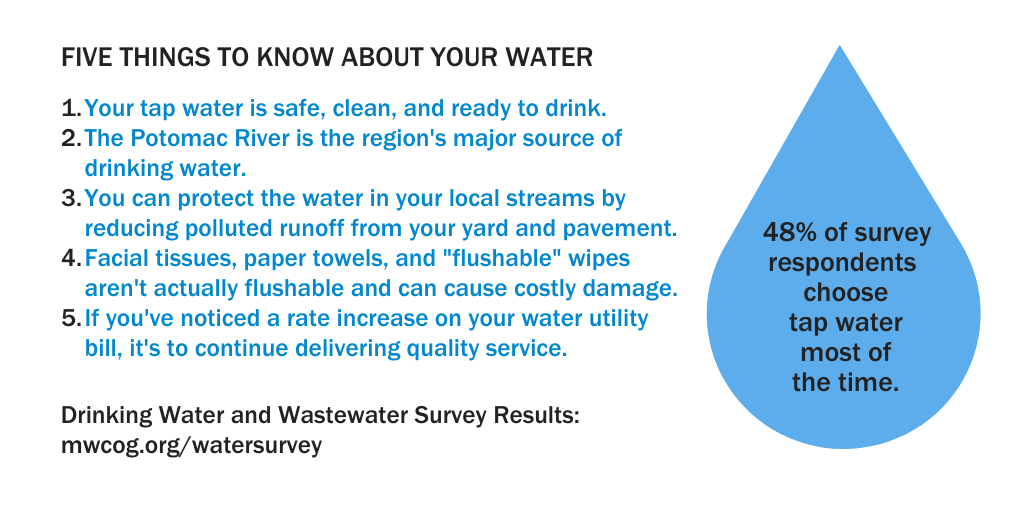How often, on average, are you washing your hands these days? More than ever, metropolitan Washington residents are relying on area water utilities to provide reliable service for handwashing, sanitation, and drinking.
A recent survey of the region's residents by the Metropolitan Washington Council of Governments (COG) revealed five things all residents should know about their water, and the service and infrastructure that makes it possible.

“This survey gives us—the region’s water and wastewater utilities—important insights about the public’s understanding of their water and wastewater services,” said Melissa Atwood, COG’s Community Engagement Campaign Chair, and Outreach Coordinator for Fairfax County Wastewater Management. “The findings help us shape the way we communicate with customers about the work our regional utilities do to ensure these life-sustaining services.”
Five things to know about your water
- Your water is safe, clean, and ready to drink from the tap.
Forty-eight percent of survey respondents reported that they drink tap water most of the time. Almost a third reported that they "rarely" or "never" drink tap, mostly due to concerns about safety of the water. Drinking water is treated to meet the stringent standards required by the Safe Drinking Water Act and enforced by the U.S. Environmental Protection Agency (EPA) and state agencies. Learn more about your drinking water by checking your local utility's website for its annual water quality report.
- The Potomac River is the major source of drinking water for metropolitan Washington residents.
Other important sources include the Patuxent River, Occoquan River, and groundwater wells. Over half of survey respondents indicated that they did not know the source of their drinking water, mirroring national trends. Water is pulled from the Potomac River upstream of Great Falls, cleaned and, then processed by area drinking water utilities, then delivered to your tap via miles of pipe.
- You can protect the water in your local streams by reducing polluted runoff from your yard and pavement.
Many survey respondents recognized that chemicals like fertilizer, car fluids, herbicide, and winter salts can be harmful to the health of local waterways, some of which flow into sources of our drinking water, like the Potomac River. Preventing pollutants from entering rivers and streams is critically important to our communities, aquatic habitats, and our water supplies. The sum of our individual actions affect the health of the water supply and protecting source water protects public health, reduces the costs of water treatment, and preserves recreational areas and wildlife habitat.
- Facial tissues, paper towels, and "flushable" wipes aren't actually flushable and can cause costly damage to your own plumbing, and the region's water infrastructure.
Frequent cleaning of surfaces, knobs, and other commonly touched areas is always encouraged, especially during the COVID-19 pandemic. Survey respondents indicated that they “sometimes” flush tissues, paper towels and wipes down the toilet, and felt that wipes labeled “flushable” were safe to flush. All of these products contribute to clogs in residential pipes and area sewer systems. They can cause costly damage to wastewater treatment equipment and sewage overflows into homes and rivers.
For example, Frederick County Division of Utilities and Solid Waste Management has noticed an increase in pump clogging due to the amount of flushable wipes—and now disposable facemasks—in the collection system. Always dispose of these items in the trash. Learn more at protectyourpipes.org.
- If you've noticed a rate increase on your water utility bill, it's to continue delivering quality service.
The majority of surveyed residents (66 percent) perceive the region's water and wastewater infrastructure to be in good condition. However, approximately a third of respondents aren't sure how rates benefit water infrastructure. Rates, in part, pay for repairing and replacing pipes and treatment plant equipment that have outlived their useful lifespan.
For example, Fairfax County Wastewater Collection Division personnel maintain over 3,300 miles of pipes, 95,000 sanitary sewer manholes, 63 wastewater pump stations, and two stormwater pump stations! Rates also support operations, ensuring quality services are delivered to customers around the clock, and preventative maintenance to keep wastewater safely moving from homes and businesses to the wastewater treatment plant, helping prevent sewer backups and overflows.
The survey was completed by 821 metropolitan Washington residents, and conducted on behalf of the 16 water and wastewater utilities and jurisdictions who collaborate on regionwide water communication and outreach as part of COG's Community Engagement Campaign. The group issues a survey annually to measure changes in water awareness and behaviors to protect area water and water infrastructure.
MORE: Annual Drinking Water and Wastewater Survey